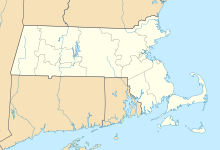Borden Flats Light facts for kids
 |
|
| 2008 photo | |
|
|
|
| Location | Taunton River, Fall River, Massachusetts |
|---|---|
| Coordinates | 41°42′16.986″N 71°10′27.825″W / 41.70471833°N 71.17439583°W |
| Year first constructed | 1875 |
| Year first lit | 1881 (current tower) |
| Automated | 1963 |
| Foundation | Cast iron and concrete caisson |
| Construction | Cast iron |
| Tower shape | Conical |
| Markings / pattern | Brown caisson, white body, black lantern |
| Height | 48 feet (15 m) |
| Focal height | 47 feet (14 m) |
| Original lens | 4th order Fresnel lens |
| Current lens | 250 millimetres (9.8 in) |
| Range | 11 nautical miles (20 km; 13 mi) |
| Characteristic | Original: Fixed red Current: Permanently Removed |
| Fog signal | Until 1983: Bell Current: None |
| Admiralty number | J0576 |
| ARLHS number | USA-072 |
| USCG number | 1-18925 |
Borden Flats Light is a historic lighthouse located in Fall River, Massachusetts. It stands in the Taunton River, which flows into Mount Hope Bay. This lighthouse is known as a "sparkplug lighthouse" because of its unique shape. It looks like a tall, narrow tower built on a strong base in the water.
The lighthouse was built in 1881 to help guide ships. It was later added to the National Register of Historic Places in 1987. This means it is recognized as an important historical site.
Contents
History of Borden Flats Light
Why the Lighthouse Was Needed
In the mid-1800s, Fall River was a busy city. It had many textile mills and steamboats traveling to Providence, Rhode Island, and New York City. The city is located where the Taunton River meets Mount Hope Bay. This area is part of Narragansett Bay.
Before the lighthouse, there was a simple marker in the water. It showed where a dangerous reef was located. This reef was a hidden rock area that could harm ships. To make shipping safer, a proper lighthouse was needed.
Building the Lighthouse
In June 1880, money was approved to build a new lighthouse. It would be placed on Borden Flats, a shallow area in the bay. The lighthouse tower was made of strong cast iron. It stood about 50-foot-tall (15 m) and included living space for the lighthouse keeper.
The light began working on October 1, 1881. It used a special lens called a Fresnel lens. This lens made a steady red light that shone 47-foot (14 m) above the water. Rainwater was collected and stored in a tank in the basement. This provided fresh water for the keeper.
Storms and Upgrades
The lighthouse faces the open water to the south. In 1938, a very strong storm, the 1938 New England hurricane, hit the area. The storm was so powerful that it tilted the lighthouse. You can still see this tilt today! After the storm, a wider base was added around the original one. This gave the lighthouse extra protection from future storms.
Over the years, the lighthouse received important upgrades. In 1957, electricity was added, making the light brighter. In 1963, the lighthouse became "automated." This means it no longer needed a keeper living there all the time. Machines took over the work.
In 1977, the old Fresnel lens was replaced with a newer, modern lens. The fog bell, which warned ships in foggy weather, was used until 1983. Then, it was replaced by an electronic foghorn.
Borden Flats Light Today
Today, Borden Flats Light is privately owned. It was bought at an auction in 2000. The new owners worked for seven years to restore this historic building. In 2018, it was sold to a local resident.
The lighthouse now offers a unique experience: you can stay overnight! It's like living the life of a lighthouse keeper from the 1800s, but with modern comforts. The lighthouse has five levels. It is decorated with old items and lighthouse souvenirs.
- The first level has a kitchen.
- The second level is a living room.
- The third level has a TV room or den.
- The fourth level has a queen-sized bedroom.
- The fifth level is the lantern room. From here, you get amazing views of Mount Hope Bay and the city of Fall River.
People from all over the world visit Borden Flats Light. It is one of only two offshore lighthouses in America where you can spend the night.
Gallery



